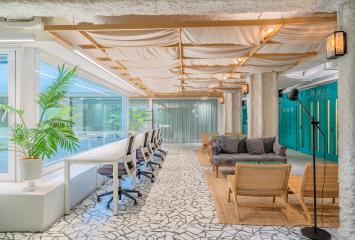Analysis of the benefits of colorful offices versus minimalist offices
Functional and Aesthetic Minimalism in Office Design
Offices designed under the principles of functional and aesthetic minimalism, which have been prevalent over the past two decades, are often warm, colorfully subdued spaces. Their predominant tones are white, black, gray, or beige. Beyond the selection of these soft, subtle tones, such offices are also characterized by a lack of excessive color combinations, maintaining a form of very limited monochromatism or polychromatism. This is in stark contrast to offices designed under new trends like maximalism or eclecticism, where vibrant colors abound.
Impact of Colorful Environments on Workers
The human psyche is not indifferent to colors. On the contrary, as scientific research on the psychology of color demonstrates, colors can significantly influence people's moods and even enhance certain cognitive abilities. For example, yellow and orange tones seem to act as a wake-up call for creativity, which is why some new office designs include these colors on the walls or furniture in brainstorming areas. Blue, on the other hand, appears to induce concentration and calm, making it ideal for immersive work or collaboration rooms.
Similarly, green tones, which humans have been surrounded by for most of their history, can provide a great deal of serenity and emotional well-being. Incorporating vegetation into the office interior is a great strategy to achieve a relaxed and satisfied workforce, as is adding green decorative elements or even opting for green walls. In short, choosing chromatic minimalism means foregoing the benefits of colors and their strategic use. This is not just about pleasing employees; it's also about building a brand.
The Role of Color in Brand Identity
Part of a brand's identity is its colors. While chromatic minimalism often hinders their representation within the office, movements like maximalism or eclecticism promote it. This clearly benefits the construction of organizational culture. Employees end up identifying with certain key tones, reinforcing the brand and the values it stands for. This reality also positively influences the attraction of new talent and the seduction of clients visiting the office. Despite the advantages of this multichromatism, there is a significant obstacle.
The Cultural Perception of Colors
It is essential to consider that color perception can vary by culture. In Western cultures, for example, white is usually associated with purity, while in some Asian cultures it is related to death. Red, on the other hand, inspires passion and love in some regions, while it signifies good luck in others. This cultural variability makes office design and its customization for a specific company something that must take into account the culture of its workers and the location. Chromatic maximalism is not arbitrary; it responds to specific needs.
Towards a New Era of Office Design
In any case, it is evident that times of change, or at least alternatives, are approaching. Chromatic minimalism, with its "less is more" approach intended to free the brain from stimuli, remains an interesting proposition but is not necessarily canonical. After all, each organization is unique and requires very specific functional and aesthetic characteristics. Color, and especially the appropriate use of color, can become an exceptional ally in motivating a workforce, making them feel at home, and providing them with the psychological tools necessary for productive functioning.

